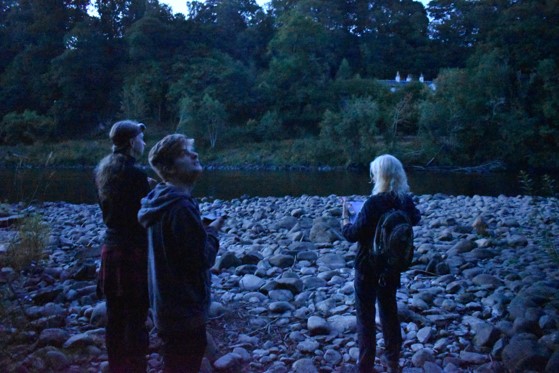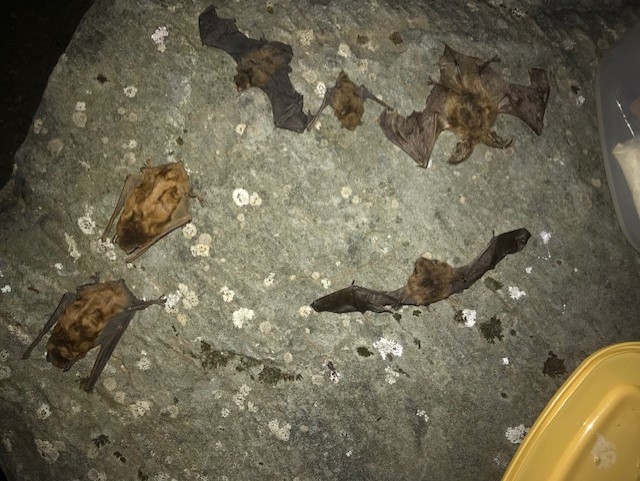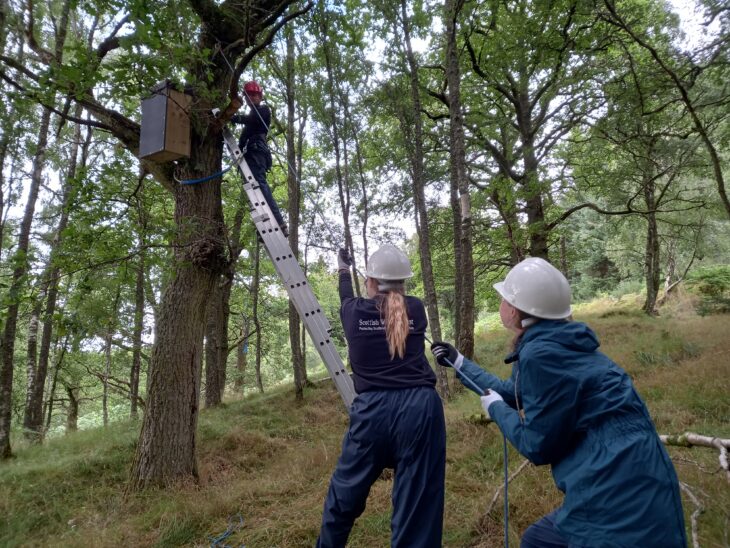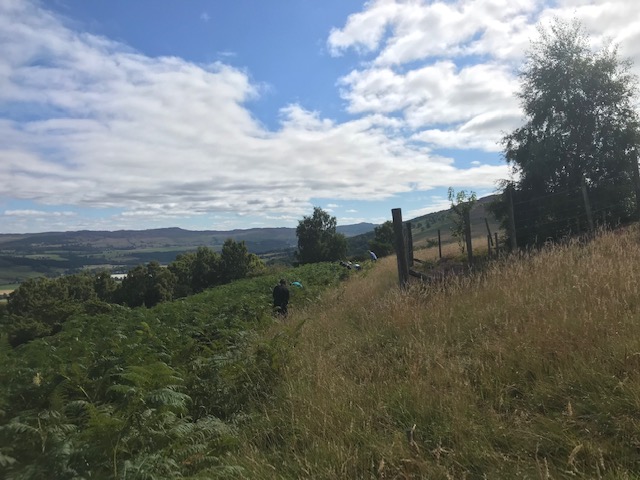Ranger Round-Up: Going Batty!
As daylight fades behind Birnam Hill and many creatures scuttle off to sleep, others are only just stirring and blinking their glittering, moon-bright eyes. Tawny owls (Strix aluco) screech and spread their wings whilst foxes (Vulpes vulpes) scamper through the fields. Alongside Fiddler’s Path, the River Tay tumbles with Atlantic Salmon (Salmo salar) and Brown Trout (Salmo trutta), their splashes startling the starlit stillness, and above them all the bats begin their boggling acrobatics. They are flitting after moths and flies—their favourite late night snacks—and doing so without a sound. Or so it seems.
We know better. Equipped with bat detectors and stop watches, the Assistant Ranger team (self-confessed budding bat fanatics) have been joining Lowes volunteer and Tayside Bat Group member Celia Holmes on bat surveys along the Birnam river path. The special devices detect the echolocation calls that bats make to search for and hone in on food during their flight. Each species makes these sounds in a variety of unique patterns and slightly different pitches, a bit like an audio fingerprint. These sounds come across on the devices as clicks or slaps, some are hushed and widely spaced, while others sound akin to a machinegun rattle. When the bats hone in on food, the clicks get closer together (known as a feeding buzz), until they sound like they are blowing raspberries.

Riparian (riverside) woodland is a scarce habitat with plenty of bat species associated with it. Pipistrelles are the most common bat inhabiting these areas and the UK as a whole. The high pitched calls of Soprano pipistrelles (Pipistrellus pygmaeus) can reach frequencies of 70kHz, which was certainly something to hear on our bat detectors, but it was the Daubenton’s bat (Myotis daubentonii) that stole the show for us on a late-night visit to Blairgowrie. This species swoops low over streams and rivers, appearing as a ghostly flash as its pale underside catches the last light reflected by the water with rapid low-frequency calls.
If you’re interested in bats and live in the Tayside area, we would highly recommend the talks led by the Tayside Bat Group. They are educational public events for all the family, so everyone can get involved! The next event will be held in Perth on Saturday 27th August at 8pm, coinciding with National Bat Night! For more details, check out their Facebook post.

The bats presented in the above photo are held under license by the Tayside Bat Group and we advise that if you ever come across a bat – dead or alive – it is unsafe to touch or handle it without wearing gloves and washing your hands afterwards. Click here for more information on what to do should you find a bat in your house.
Some of you might be reading this and thinking, ‘But isn’t that a bit dangerous, wandering around in the dark waving bat detectors about?’ and we are grateful for your concern. However, we are now qualified outdoor emergency first-aiders following a two day course with instructors Pete and Fraser from the British Association of Ski Patrollers (BASP), so if something did happen we were well prepared to wave our certificates and make everything better. We certainly rehearsed a wide selection of scenarios during the course, including all of the usual: cardiac arrest, choking, concussions, broken limbs, and burning yourself on a pot of scrumptious pasta. Really, though, it should have been BAFTAs we were receiving for all of our brilliant acting.
We’ve also spent time helping Gareth from Forestry and Land Scotland (with the indispensable help of Freya, his energetic pointer with a passion for sucking thumbs) put up pine marten boxes! Pine marten (Martes martes (as we have discovered to our frustration this season) are very elusive. They are exceptional climbers and den in trees; usually this will be in holes, old squirrel dreys, or even large raptor nests, but occasionally some kind people with ladders and pulleys will provide a cosy little nest box that they’ll take to instead. Inevitably they like their homes to be in places that are difficult to access with ladders and climbing equipment, so we spent as much of the day investigating the lay of the ground beneath our feet as we did the trees, but we now have three new den boxes successfully on the pine marten house market! So if you know of any martens looking to get a foot on the property ladder, point them in our direction.

In other news, our battle against the bracken has switched frontiers from Keltneyburn to Balnaguard. Situated on a steep hill with stunning views from the top, the Trust’s Balnaguard Glen Reserve is a beautiful mosaic of woodland and open grassland gnarled with studs of heather and spiky juniper. Common Juniper (Juniperus communis) is a squat, woody tree native to the UK and valuable to wildlife in many ways; it provides cover for nesting birds such as black grouse (Tetrao tetrix) and it is a food source for caterpillars and moths including the Juniper Carpet Moth (Thera juniperata) as well as for birds like Fieldfares (Turdus pilaris) and Mistle Thrushes (Turdus viscivorus).

Unfortunately, juniper is in decline. Junipers are failing to properly regenerate as a consequence of deer and sheep browsing, but also because of their susceptibility to Phytophera root rot, which is contracted via the plant’s root system and causes foliage to die. The reserve at Balnaguard has a deer fence surrounding it, but it is not so easy to keep the fungus-like Phytophera from being trampled onto site by unsuspecting boots. A way you can help prevent the spread of Phytophera is by washing and disinfecting your shoes before and after entering the reserve or anywhere with juniper, which we admit can be tricky when on a steep hill trying to balance on one leg with a brush and spray bottle! Unfortunately, suffocating stands of bracken are not helping the juniper grow any better, but a few days of grass-hooking in the sweltering sun with the help of some other valiant volunteers has freed the juniper of one of its vices at least.
That wraps up our list of escapades this week, but keep an eye out for our next blog for more insights into what we get up to as seasonal assistant rangers here at Loch of the Lowes.
Assistant Ranger Team
Help protect Scotland’s wildlife
Our work to save Scotland’s wildlife is made possible thanks to the generosity of our members and supporters.
Join today from just £3 a month to help protect the species you love.
Preface
As daylight fades behind Birnam Hill and many creatures scuttle off to sleep, others are only just stirring and blinking their glittering, moon-bright eyes. Tawny owls (Strix aluco) screech and spread …
